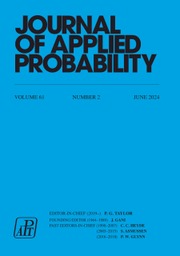No CrossRef data available.
Article contents
Optimal multiple stopping problem with irregular reward
Published online by Cambridge University Press: 14 July 2025
Abstract
In this paper we study the optimal multiple stopping problem with weak regularity for the reward, where the reward is given by a set of random variables indexed by stopping times. When the reward family is upper semicontinuous in expectation along stopping times, we construct the optimal multiple stopping strategy using the auxiliary optimal single stopping problems. We also obtain the corresponding results when the reward is given by a progressively measurable process.
MSC classification
Information
- Type
- Original Article
- Information
- Copyright
- © The Author(s), 2025. Published by Cambridge University Press on behalf of Applied Probability Trust
References
Ben Latifa, I., Bonnans, J. F. and Mnif, M. (2011). Optimal multiple stopping problem and financial applications. Research Report RR-7807, INRIA. Available at https://inria.hal.science/hal-00642919/PDF/RR-7807.pdfhal-00642919.Google Scholar
Borovkova, S. and Schmeck, M. D. (2017). Electricity price modeling with stochastic time change. Energy Econom. 63, 51–65.CrossRefGoogle Scholar
Bouzguenda Zeghal, A. and Mnif, M. (2006). Optimal multiple stopping and valuation of swing options in Lévy models. Internat. J. Theor. Appl. Finance. 9, 1267–1297.CrossRefGoogle Scholar
Carmona, R. and Touzi, N. (2008). Optimal multiple stopping and valuation of swing options. Math. Finance 18, 239–268.CrossRefGoogle Scholar
El Karoui, N. (1981). Les aspects probabilistes du controle stochastique. In Ecole d’Eté de Probabilités de Saint-Flour IX (Lecture Notes in Mathematics 876), pp. 73–238. Springer, Berlin.CrossRefGoogle Scholar
Karatzas, I. and Shreve, S. E. (1998). Methods of Mathematical Finance (Applications of Mathematics 39). Springer, New York.Google Scholar
Kobylanski, M. and Quenez, M. C. (2012). Optimal stopping time problem in a general framework. Electron. J. Prob. 17, 1–28.CrossRefGoogle Scholar
Kobylanski, M., Quenez, M. C. and Rouy-Mironescu, E. (2011). Optimal multiple stopping time problem. Ann. Appl. Prob. 21, 1364–1399.CrossRefGoogle Scholar
Li, H. (2022). Optimal multiple stopping problems under g-expectation. Appl. Math. Optim. 85, 17.CrossRefGoogle Scholar
Li, H. (2023). Optimal multiple stopping problem under nonlinear expectation. Adv. Appl. Prob. 55, 151–178.CrossRefGoogle Scholar
Peskir, G. and Shiryaev, A. N. (2006). Optimal Stopping and Free-Boundary Problems. Birkhäuser.Google Scholar
Scheutzow, M. (2019). BMS Basic Course Stochastic Processes II/Wahrscheinlichkeitstheorie III.
Google Scholar


